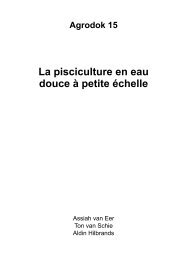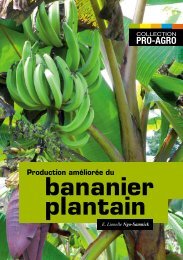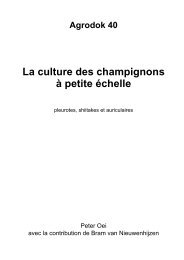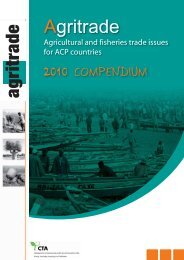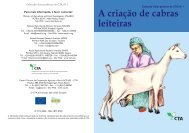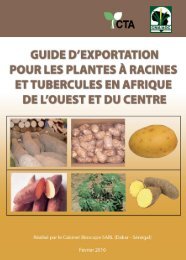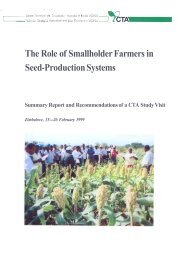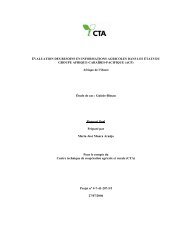La conservation du poisson et de la viande - Anancy
La conservation du poisson et de la viande - Anancy
La conservation du poisson et de la viande - Anancy
- No tags were found...
You also want an ePaper? Increase the reach of your titles
YUMPU automatically turns print PDFs into web optimized ePapers that Google loves.
7 Fermentation <strong>du</strong> <strong>poisson</strong>7.1 GénéralitésLe <strong>poisson</strong> représente une importante source <strong>de</strong> protéines pourl’alimentation quotidienne, mais il a l’inconvénient <strong>de</strong> s’avarier trèsrapi<strong>de</strong>ment. Un <strong>poisson</strong> non cuit, non salé, non séché, non fumé ounon conservé d’une manière ou d’une autre s’altère rapi<strong>de</strong>ment. Dansle Sud-Est asiatique, <strong>la</strong> fermentation est <strong>la</strong> métho<strong>de</strong> <strong>la</strong> plus courante <strong>de</strong><strong>conservation</strong> <strong>du</strong> <strong>poisson</strong>. Les pâtes <strong>et</strong> les sauces <strong>de</strong> <strong>poisson</strong> fermentéesoccupent une p<strong>la</strong>ce beaucoup plus gran<strong>de</strong> dans l’alimentation quotidienneque le <strong>poisson</strong> salé ou séché. Elles perm<strong>et</strong>tent <strong>de</strong> varier le régimealimentaire monotone composé principalement <strong>de</strong> riz. Bien queles pro<strong>du</strong>its fermentés soient une bonne source <strong>de</strong> protéines, ils nesont consommables qu’en quantité limitée à cause <strong>de</strong> leur haute teneuren sel. <strong>La</strong> fermentation <strong>du</strong> <strong>poisson</strong> est surtout appliquée dans les régionsoù le séchage est impossible à cause d’un climat trop humi<strong>de</strong>, <strong>et</strong>où <strong>la</strong> réfrigération <strong>et</strong> <strong>la</strong> stérilisation sont trop coûteuses.7.2 FermentationPendant <strong>la</strong> fermentation <strong>du</strong> <strong>poisson</strong>, <strong>la</strong> protéine est dégradée en présenced’une haute concentration en sel par <strong>de</strong>s enzymes originaires <strong>du</strong><strong>poisson</strong> lui-même ; ces enzymes sont surtout présentes dans l’intestin.L’éviscération <strong>du</strong> <strong>poisson</strong>, préconisée dans les métho<strong>de</strong>s traditionnelles<strong>de</strong> fermentation, ralentit souvent <strong>la</strong> fermentation car <strong>la</strong> chair <strong>du</strong><strong>poisson</strong> éviscéré contient moins d’enzymes.Rôle <strong>de</strong>s micro-organismesLes micro-organismes ne jouent probablement aucun rôle dans <strong>la</strong> dégradation<strong>de</strong> <strong>la</strong> protéine pendant <strong>la</strong> fermentation <strong>du</strong> <strong>poisson</strong>. Cependant,les micro-organismes résistants au sel (à cause <strong>de</strong>s gran<strong>de</strong>s quantités<strong>de</strong> sel utilisées pour <strong>la</strong> fermentation <strong>du</strong> <strong>poisson</strong>) semblent contribuerà <strong>la</strong> formation <strong>de</strong> <strong>la</strong> saveur <strong>et</strong> <strong>de</strong> l’o<strong>de</strong>ur spécifiques <strong>du</strong> pro<strong>du</strong>itfermenté.56<strong>La</strong> <strong>conservation</strong> <strong>du</strong> <strong>poisson</strong> <strong>et</strong> <strong>de</strong> <strong>la</strong> vian<strong>de</strong>




